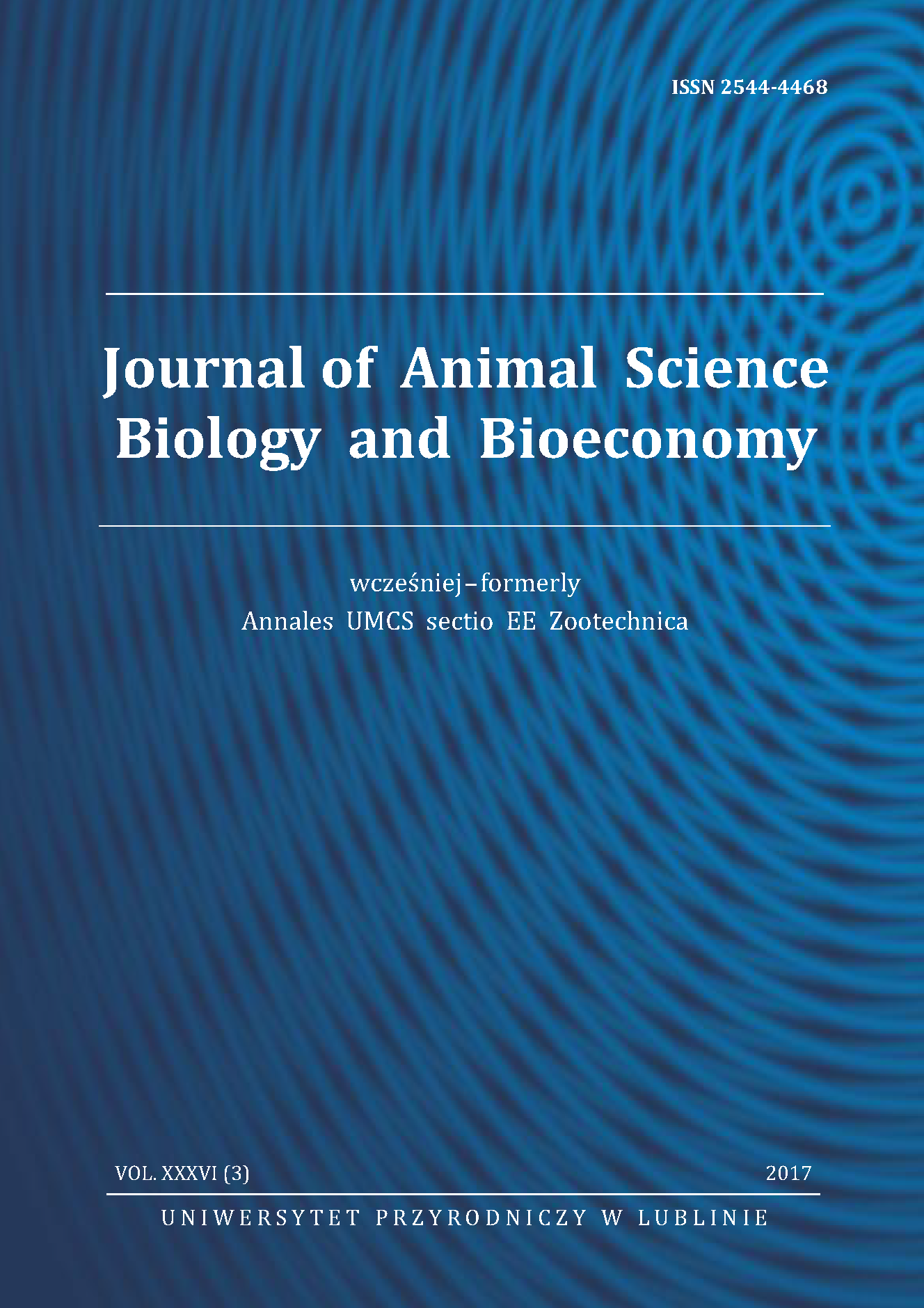Analysis of the arachnophobia level based on contact with spiders and the Fear of Spiders Questionnaire
Joanna Kapustka
Department of Animal Ethology and Wildlife Management, University of Life Sciences in Lublinhttps://orcid.org/0000-0001-8175-7299
Damian Zieliński
University of Life Sciences in Lublin, Faculty of Animal Sciences and Bioeconomy, Department of Animal Ethology and Wildlife Management, Akademicka 13, 20-950 Lublinhttps://orcid.org/0000-0001-8175-7299
Patrycja Borowiec
University of Life Sciences in Lublin, Faculty of Animal Sciences and Bioeconomy, Student Scientific Association of Animal Sciences and Bioeconomy, Section of Animal Therapy and Animal Care, Akademicka 13, 20-950 Lublin, Polandhttps://orcid.org/0000-0002-3278-7966
Damian Gos
University of Life Sciences in Lublin, Faculty of Animal Sciences and Bioeconomy, Student Scientific Association of Animal Sciences and Bioeconomy, Section of Animal Therapy and Animal Care, Akademicka 13, 20-950 Lublin, Polandhttps://orcid.org/0000-0002-3671-2507
Wiktoria Czupryna
University of Life Sciences in Lublin, Faculty of Animal Sciences and Bioeconomy, Student Scientific Association of Animal Sciences and Bioeconomy, Section of Animal Therapy and Animal Care, Akademicka 13, 20-950 Lublin, Polandhttps://orcid.org/0000-0002-6890-9419
Abstract
Arachnophobia is one of the most common phobias in society. The study was based on an online survey and a stationary study. The questionnaire was completed by 364 respondents. In the first part the respondents determined their level of arachnophobia on the Likert scale (IOA, individual assessment of arachnophobia), and in the second part completed the Fear of Spiders Questionnaire (FSQ). Near 50% of respondents declared fear of spiders. There was a positive correlation between the FSQ results and IOA. In stationary study took part 7 women. Before the study, they completed the questionnaire from the first part of the study. During the study, the participants observed three spiders and the moult. Before, during, and after the study heart rate was measured. The mean score of the FSQ study was 103 and IOA scored between 5 to 7. The mean heart rate during contact with spiders was 113 bpm. Contact with spiders was a stressful situation, but the heart rate decreased just after 5 min.
Keywords:
stress, spiders, arachnophobia, Fear of Spiders QuestionnaireReferences
Adamczyk K., Adamczyk D., Wójcik R., Fałkowska U., Soroka E., 2018. Rzadkie fobie specyficzne – rodzaje i leczenie [Rare specific phobias – types and treatment]. Varia Med. 2(5), 423–429.
Bartoń J., Blaut A., 2011. Efektywność muzyki relaksacyjnej (klasycznej i wybranej samodzielnie) w terapii behawioralnej kobiet z arachnofobią [The effectiveness of classical and self-selected relaxing music in the behavioural treatment of women with arachnophobia]. Psychoterapia 4(159), 41–50.
Bernstein D.A., Allen G.J., 1969. Fear survey schedule (II): normative data and factor analyses based upon a large college sample. Behav Res Ther, 7, 403–407. https://doi.org/10.1016/0005-7967(69)90072-2 DOI: https://doi.org/10.1016/0005-7967(69)90072-2
Bilikiewicz A., 2011. Psychiatria – podręcznik dla studentów medycyny [Psychiatry – a textbook for medical students]. Wydawnictwo Lekarskie PZWL, Warszawa, Poland, 748.
Binder F.P., Pöhlchen D., Zwanzger P., Spoormaker V.I., 2022. Facing your fear in immersive virtual reality: avoidance behavior in specific phobia. Front. Behav. Neurosci. 16, 827673. http://doi.org/10.3389/fnbeh.2022.827673 DOI: https://doi.org/10.3389/fnbeh.2022.827673
Bouchard S., Cote S., St-Jackues J., Robillard G., Renaud P., 2006. Effectiveness of virtual reality exposure in the treatment of arachnophobia using 3D games. Technol. Health Care 14, 19–27. DOI: https://doi.org/10.3233/THC-2006-14103
Choy Y., Fyer A.J., Lipsitz J.D., 2007. Treatment of specific phobia in adults. Clin. Psychol. Rev. 27, 266–286. http://doi.org/10.1016/J.CPR.2006.10.002 DOI: https://doi.org/10.1016/j.cpr.2006.10.002
Cohen C.J., Muehl G.E., 1977. Human orcadian rhythms in resting and exercise pulse. Ergonomics. 20(5), 475–479. http://doi.org/10.1080/00140137708931656 DOI: https://doi.org/10.1080/00140137708931656
Cornelius R.R., Averill J.R., 1983. Sex differences in fear of spiders. J. Pers. Soc. Psychol. 45(2), 377–383. https://doi.org/10.1037/0022-3514.45.2.377 DOI: https://doi.org/10.1037/0022-3514.45.2.377
Granado L.C., Ranvauda R., Peláez J.R., 2007. A spiderless arachnophobia therapy: comparison between placebo and treatment groups and six-month follow-up study. Neural Plast. 10241. https://doi.org/10.1155/2007/10241 DOI: https://doi.org/10.1155/2007/10241
Gulla B., 2015. Wirtualne perspektywy praktyki psychologicznej. In: M. Wycocka-Pleczyk, B. Gulla, Człowiek zalogowany, vol. 4. Człowiek społeczny w przestrzeni Internetu [Virtual perspectives for psychological practice. In: M. Wycocka-Pleczyk, B. Gulla, The logged-in man, vol. 4. The social man in the Internet space]. Biblioteka Jagiellońska, Kraków, 116–127.
Hauke T.J., Herzig V., 2017. Dangerous arachnids – fake news or reality?. Toxicon 138, 173–183. https://doi.org/10.1016/j.toxicon.2017.08.024 DOI: https://doi.org/10.1016/j.toxicon.2017.08.024
Katkin E.S., Hoffman L.S., 1976. Sex differences and self-report of fear: a psychophysiological assessment. J. Abnorm. Psychol. 85(6), 607–610. DOI: https://doi.org/10.1037/0021-843X.85.6.607
Kim H.-G., Cheon E.-J., Bai D.-S., Lee Y.H., Koo B.-H., 2017. Stress and heart rate variability: a meta-analysis and review of the literature. Psychiatry Investig. 15(3), 235–245. https://doi.org/10.30773/pi.2017.08.17 DOI: https://doi.org/10.30773/pi.2017.08.17
Landová E., Janovcová M., Štolhoferová I., Rádlová S., Frýdlová P., Sedláčková K., Frynta D., 2021. Specificity of spiders among fear- and disgust-eliciting arthropods: spiders are special, but phobics not so much. PLoS ONE 16(9), e0257726. https://doi.org/10.1371/journal.pone.0257726 DOI: https://doi.org/10.1371/journal.pone.0257726
Muris P., Merckelbach H., 1996. A comparison of two spider fear questionnaires. J. Behav. Ther. Exp. Psychiat. 27(3), 241–244. https://doi.org/10.1016/s0005-7916(96)00022-5 DOI: https://doi.org/10.1016/S0005-7916(96)00022-5
Mühlberge A., Sperber M., Wieser M.J., Pauli P., 2008. A virtual reality behavior avoidance test (vr-bat) for the assessment of spider phobia. J. Cyber. Ther. Rehabil. 1(2), 147–158. DOI: https://doi.org/10.1037/t71548-000
Polák J., Sedláčková K., Janovcová M., Peléšková S., Flegr J., Vobrubová B., Frynta D., Landová E., 2022. Measuring fear evoked by the scariest animal: Czech versions of the Spider Questionnaire and Spider Phobia Beliefs Questionnaire. BMC Psychiatry 22, 18. https://doi.org/10.1186/s12888-021-03672-7 DOI: https://doi.org/10.1186/s12888-021-03672-7
Prokop P., Tolarovičová A., Camerikn A.M., Peterková V., 2010. High school students’ attitudes towards spiders: a cross‐cultural comparison. Int. J. Sci. Educ. 32(12), 1665–1688. https://doi.org/10.1080/09500690903253908 DOI: https://doi.org/10.1080/09500690903253908
Skokan E.G., Herman B.E., 1999. Bites that poison: a tale of spiders, snakes, and scorpions. Contemp. Pediatr. 16(8), 41.
Skotnicka M., Mitas A.W., 2014. About the measurement methods in music therapy. In: E. Pietka, J. Kawa, W. Wieclawek (ed.), Information Technologies in Biomedicine, vol. 4. Advances in Intelligent Systems and Computing 284. Springer, Cham, 203–214. https://doi.org/10.1007/978-3-319-06596-0_19 DOI: https://doi.org/10.1007/978-3-319-06596-0_19
Szymanski J., O’Donohue W., 1995. Fear of Spiders Questionnaire. J. Behav. Ther. Exp. Psychiatry 26, 31–34. https://doi.org/10.1016/0005-7916(94)00072-T DOI: https://doi.org/10.1016/0005-7916(94)00072-T
Wawrzała P., Kciuk M., Kopeć M., 2020. Zastosowanie bezprzewodowego czujnika tętna w systemie biofeedback. In: J. Roj (ed.), Metrologia naukowa, normatywna i przemysłowa. Wybrane zagadnienia [The use of a wireless heart rate sensor in the biofeedback system. In: J. Roj (ed.), Scientific, normative and industrial metrology. Selected issues]. Wydawnictwo Politechniki Śląskiej, Gliwice, 340.
Wittchen H.U., Jacobi F., Rehm J., Gustavsson A., Svensson M., Jönsson B., Olesen J., Allgulander C., Alonso J., Faravelli C., Fratiglioni L., Jennum P., Lieb R., Maercker A., van Os J., Preisig M., Salvador-Carulla L., Simon R., Steinhausen H.C., 2011. The size and burden of mental disorders and other disorders of the brain in Europe 2010. Eur. Neuropsychopharmacol. 21, 655–679. https://doi.org/10.1016/j.euroneuro.2011.07.018 DOI: https://doi.org/10.1016/j.euroneuro.2011.07.018
Woody S.R., McLean C., Klassen T., 2005. Disgust as a motivator of avoidance of spiders. J. Anxiety Disord. 19, 461–475. https://doi.org/10.1016/j.janxdis.2004.04.002 DOI: https://doi.org/10.1016/j.janxdis.2004.04.002
Żołnowski M., Lebiedź J., 2014. Wspomaganie leczenia fobii za pomocą zanurzenia w rzeczywistość wirtualną. In: Procceedings of ICT Young 2014. IV Konferencja Studentów i Doktorantów Elektroniki, Telekomunikacji, Informatyki, Automatyki I Robotyki [Supporting the treatment of phobias through immersion in virtual reality. In: Procceedings of ICT Young 2014. 4th Conference of Students and Doctoral Students of Electronics, Telecommunications, Computer Science, Automation and Robotics], Gdańsk, 1–6.
Department of Animal Ethology and Wildlife Management, University of Life Sciences in Lublin https://orcid.org/0000-0001-8175-7299
University of Life Sciences in Lublin, Faculty of Animal Sciences and Bioeconomy, Department of Animal Ethology and Wildlife Management, Akademicka 13, 20-950 Lublin https://orcid.org/0000-0001-8175-7299
University of Life Sciences in Lublin, Faculty of Animal Sciences and Bioeconomy, Student Scientific Association of Animal Sciences and Bioeconomy, Section of Animal Therapy and Animal Care, Akademicka 13, 20-950 Lublin, Poland https://orcid.org/0000-0002-3278-7966
University of Life Sciences in Lublin, Faculty of Animal Sciences and Bioeconomy, Student Scientific Association of Animal Sciences and Bioeconomy, Section of Animal Therapy and Animal Care, Akademicka 13, 20-950 Lublin, Poland https://orcid.org/0000-0002-3671-2507
University of Life Sciences in Lublin, Faculty of Animal Sciences and Bioeconomy, Student Scientific Association of Animal Sciences and Bioeconomy, Section of Animal Therapy and Animal Care, Akademicka 13, 20-950 Lublin, Poland https://orcid.org/0000-0002-6890-9419
License

This work is licensed under a Creative Commons Attribution 4.0 International License.
From 2022 articles are made available under Creative Commons Attribution 4.0 International licence (CC BY 4.0). Articles published before 2022 are available under Creative Commons Attribution – Non-commercial use – No derivative works 4.0 International licence (CC BY-NC-ND 4.0).
Submission of the paper implies that it has not been published previously, that it is not under consideration for publication elsewhere.




